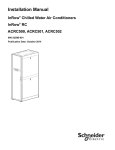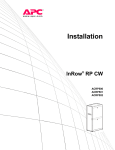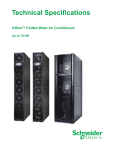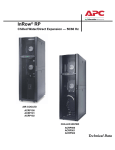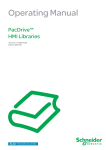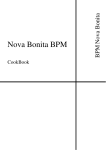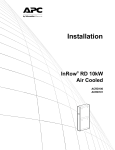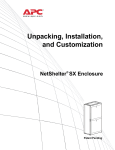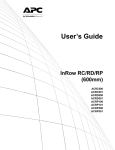Download APC ACRC500 User manual
Transcript
Installation InRow™ RC ACRC500 ACRC501 ACRC502 This manual is available in English on the enclosed CD. Uživatelská pøíruèka v èeštinì je k dispozici na pøiloženém CD. Dieses Handbuch ist in Deutsch auf der beiliegenden CD-ROM verfügbar. Deze handleiding staat in het Nederlands op de bijgevoegde cd. Este manual está disponible en español en el CD-ROM adjunto. Ce manuel est disponible en français sur le CD-ROM ci-inclus. A hasznalati utasitas magyarul megtalalhato a csatolt CD-n. Questo manuale è disponibile in italiano nel CD-ROM allegato. Denne manualen er tilgjengelig på norsk på vedlagte CD. Instrukcja Obs ugi w jezyku polskim jest dostepna na CD. O manual em Português está disponível no CD-ROM em anexo. Denna manual finns tillgänglig på svenska på medföljande CD. Bu kullanim kilavuzunun Türkçe'sä, äläxäkte gönderälen CD äçeräsände mevcuttur. . American Power Conversion Legal Disclaimer The information presented in this manual is not warranted by the American Power Conversion Corporation to be authoritative, error free, or complete. This publication is not meant to be a substitute for a detailed operational and site specific development plan. Therefore, American Power Conversion Corporation assumes no liability for damages, violations of codes, improper installation, system failures, or any other problems that could arise based on the use of this Publication. The information contained in this Publication is provided as is and has been prepared solely for the purpose of evaluating data center design and construction. This Publication has been compiled in good faith by American Power Conversion Corporation. However, no representation is made or warranty given, either express or implied, as to the completeness or accuracy of the information this Publication contains. IN NO EVENT SHALL AMERICAN POWER CONVERSION CORPORATION, OR ANY PARENT, AFFILIATE OR SUBSIDIARY COMPANY OF AMERICAN POWER CONVERSION CORPORATION OR THEIR RESPECTIVE OFFICERS, DIRECTORS, OR EMPLOYEES BE LIABLE FOR ANY DIRECT, INDIRECT, CONSEQUENTIAL, PUNITIVE, SPECIAL, OR INCIDENTAL DAMAGES (INCLUDING, WITHOUT LIMITATION, DAMAGES FOR LOSS OF BUSINESS, CONTRACT, REVENUE, DATA, INFORMATION, OR BUSINESS INTERRUPTION) RESULTING FROM, ARISING OUT, OR IN CONNECTION WITH THE USE OF, OR INABILITY TO USE THIS PUBLICATION OR THE CONTENT, EVEN IF AMERICAN POWER CONVERSION CORPORATION HAS BEEN EXPRESSLY ADVISED OF THE POSSIBILITY OF SUCH DAMAGES. AMERICAN POWER CONVERSION CORPORATION RESERVES THE RIGHT TO MAKE CHANGES OR UPDATES WITH RESPECT TO OR IN THE CONTENT OF THE PUBLICATION OR THE FORMAT THEREOF AT ANY TIME WITHOUT NOTICE. Copyright, intellectual, and all other proprietary rights in the content (including but not limited to software, audio, video, text, and photographs) rests with American Power Conversion Corporation or its licensors. All rights in the content not expressly granted herein are reserved. No rights of any kind are licensed or assigned or shall otherwise pass to persons accessing this information. This Publication shall not be for resale in whole or in part. Contents General Information ........................................................ 1 Safety . . . . . . . . . . . . . . . . . . . . . . . . . . . . . . . . . . . . . . . . . . . . . . . . . . . 1 Inspecting the Equipment . . . . . . . . . . . . . . . . . . . . . . . . . . . . . . . . . . 2 Storing the Equipment Before Installation . . . . . . . . . . . . . . . . . . . . . 2 Moving the Equipment . . . . . . . . . . . . . . . . . . . . . . . . . . . . . . . . . . . . . 2 Moving the equipment to its final location . . . . . . . . . . . . . . . . . . 2 Model Identification . . . . . . . . . . . . . . . . . . . . . . . . . . . . . . . . . . . . . . . 3 Component Identification. . . . . . . . . . . . . . . . . . . . . . . . . . . . . . . . . . . 4 Install kit inventory . . . . . . . . . . . . . . . . . . . . . . . . . . . . . . . . . . . 4 Exterior components . . . . . . . . . . . . . . . . . . . . . . . . . . . . . . . . . . 5 Interior components (front) . . . . . . . . . . . . . . . . . . . . . . . . . . . . . 6 Interior components (rear) . . . . . . . . . . . . . . . . . . . . . . . . . . . . . . 7 Electrical panel . . . . . . . . . . . . . . . . . . . . . . . . . . . . . . . . . . . . . . 8 Piping Diagrams . . . . . . . . . . . . . . . . . . . . . . . . . . . . . . . . . . . . . . . . . . 9 Connections . . . . . . . . . . . . . . . . . . . . . . . . . . . . . . . . . . . . . . . . . . . . 10 Pre-Installation . . . . . . . . . . . . . . . . . . . . . . . . . . . . . . . . . . . . . . . . . . 11 Room preparation . . . . . . . . . . . . . . . . . . . . . . . . . . . . . . . . . . . 11 Air distribution . . . . . . . . . . . . . . . . . . . . . . . . . . . . . . . . . . . . . . 11 Incoming power supply requirements . . . . . . . . . . . . . . . . . . . . 11 Service access . . . . . . . . . . . . . . . . . . . . . . . . . . . . . . . . . . . . . . 12 Dimensions and Weight . . . . . . . . . . . . . . . . . . . . . . . . . . . . . . . . . . . 13 Dimensions . . . . . . . . . . . . . . . . . . . . . . . . . . . . . . . . . . . . . . . . 13 Weight . . . . . . . . . . . . . . . . . . . . . . . . . . . . . . . . . . . . . . . . . . . . 13 Piping and Power Access Locations . . . . . . . . . . . . . . . . . . . . . . . . 14 Top piping and power access locations (top view) . . . . . . . . . . . 14 Bottom piping and power access locations (bottom view) . . . . . 15 InRow RC Installation i Installation...................................................................... 17 Removing the Doors and Panels. . . . . . . . . . . . . . . . . . . . . . . . . . . . 17 Removing the front and rear doors . . . . . . . . . . . . . . . . . . . . . . .17 Removing the side panel . . . . . . . . . . . . . . . . . . . . . . . . . . . . . .18 Installing the side panel . . . . . . . . . . . . . . . . . . . . . . . . . . . . . . .18 Removing the electrical panel cover . . . . . . . . . . . . . . . . . . . . . .19 Joining the Equipment to Enclosures . . . . . . . . . . . . . . . . . . . . . . . 20 Joining to NetShelter™ SX enclosures . . . . . . . . . . . . . . . . . . . .20 Joining to NetShelter VX and VS enclosures . . . . . . . . . . . . . . . .20 Leveling the Equipment . . . . . . . . . . . . . . . . . . . . . . . . . . . . . . . . . . . 21 Mechanical Connections . . . . . . . . . . . . . . . . . . . . . . . . . . . . . . . . . . 22 Top water piping . . . . . . . . . . . . . . . . . . . . . . . . . . . . . . . . . . . .22 Bottom water piping . . . . . . . . . . . . . . . . . . . . . . . . . . . . . . . . . .23 Condensate pump . . . . . . . . . . . . . . . . . . . . . . . . . . . . . . . . . . .25 Condensate overflow . . . . . . . . . . . . . . . . . . . . . . . . . . . . . . . . .26 Leak sensor . . . . . . . . . . . . . . . . . . . . . . . . . . . . . . . . . . . . . . . .27 Filling and Purging the Unit. . . . . . . . . . . . . . . . . . . . . . . . . . . . . . . . 28 Chiller. . . . . . . . . . . . . . . . . . . . . . . . . . . . . . . . . . . . . . . . . . . . . . . . . . 29 InRow RC requirements . . . . . . . . . . . . . . . . . . . . . . . . . . . . . . .29 Electrical Connections . . . . . . . . . . . . . . . . . . . . . . . . . . . . . . . . . . . . 30 User interface connectors . . . . . . . . . . . . . . . . . . . . . . . . . . . . .31 Description of user interface connectors . . . . . . . . . . . . . . . . . .32 Rack temperature sensors . . . . . . . . . . . . . . . . . . . . . . . . . . . . .33 Water outlet temperature sensors . . . . . . . . . . . . . . . . . . . . . . . .34 Communication connections . . . . . . . . . . . . . . . . . . . . . . . . . . .34 Network port . . . . . . . . . . . . . . . . . . . . . . . . . . . . . . . . . . . . . . .36 Power Connections . . . . . . . . . . . . . . . . . . . . . . . . . . . . . . . . . . . . . . 37 Wiring configurations . . . . . . . . . . . . . . . . . . . . . . . . . . . . . . . . .37 Install power cords (ACRC500 and ACRC502 only) . . . . . . . . . . .37 Top routing . . . . . . . . . . . . . . . . . . . . . . . . . . . . . . . . . . . . . . . .38 Bottom routing . . . . . . . . . . . . . . . . . . . . . . . . . . . . . . . . . . . . . .38 Strain relief (ACRC502 only) . . . . . . . . . . . . . . . . . . . . . . . . . . . .39 Voltage selection . . . . . . . . . . . . . . . . . . . . . . . . . . . . . . . . . . . .39 ii InRow RC Installation General Information Safety Read and adhere to the following important safety considerations when working with this cooling unit. DANGER HAZARD OF ELECTRIC SHOCK • Do not wear jewelry when working near energized components. • Before performing and service, properly de-energize and remove access to the equipment (Lockout), Physically label the equipment as intentionally out of service. Failure to follow these instructions can result in death or serious injury. WARNING HAZARD FROM MOVING PARTS Keep hands, clothing, and jewelry away from moving parts. Check the equipment for foreign objects before closing the doors and starting the equipment. Failure to follow these instructions can result in death, serious injury, or equipment damage. WARNING DAMAGE TO EQUIPMENT OR PERSONNEL The equipment is heavy. For safety purposes, adequate personnel must be present when moving this equipment. Failure to follow these instructions can result in death, serious injury, or equipment damage. CAUTION HAZARD TO EQUIPMENT OR PERSONNEL All work must be performed by American Power Conversion (APC™) by Schnieder Electric authorized personnel. Failure to follow these instructions can result in death, serious injury, or equipment damage. InRow RC Installation 1 Inspecting the Equipment Your APC InRow RC Full Rack air conditioner has been tested and inspected for quality assurance before shipment from APC. Carefully inspect both the exterior and interior of the equipment immediately upon receipt to ensure that the equipment has not been damaged during transit. Verify that all parts ordered were received as specified and that the equipment is the correct type, size and voltage. Filing a claim. If damage is identified on receipt of the equipment, note the damage on the bill of lading and file a damage claim with the shipping company. Contact APC Worldwide Customer Support at one of the numbers listed on the back page of this manual for information on how to file a claim with the shipping company. The shipping claim must be filed at the receiving end of the delivery. Note: In case of shipping damage, do not operate the equipment. Keep all packaging for inspection by the shipping company and contact APC. Storing the Equipment Before Installation If the equipment will not be installed immediately, store it in a safe place, protected from the weather. CAUTION DAMAGE FROM EXPOSURE Leaving the equipment uncovered and exposed to possible damage from the environment will void the factory warranty. Failure to follow these instructions can result in equipment damage. Moving the Equipment Moving the equipment to its final location The recommended tools for moving the equipment while it is still on the pallet include the following: Pallet jack Forklift Note: The equipment can be rolled to its final location using its casters if the floor is smooth and clean. 2 InRow RC Installation Model Identification The model number can be found on the outside of the shipping crate and on the nameplate located inside the unit as shown. Use the table below to verify that the unit is the correct size and voltage. Model Configuration ACRC500 Chilled water ACRC501 Chilled water ACRC502 Chilled water Voltage Frequency Air Pattern 200-240 460-480 380-415 50-60 Hz 60 Hz 50-60 Hz Back to front Back to front Back to front Nameplate InRow RC Installation 3 Component Identification na2732a Install kit inventory Item Description Union end Quantity 2 Item Description Strain relief, metal (ACRC502 only) Wire clip Top power cord set (ACRC500 and 1 ACRC502 only) PLC pipe thread, shutoff, 3/8-in 1 Tie wrap BSPT* for condensate drain connection Extension adapter 2 Tie wrap (field wiring) Temperature sensor 3 Resistor, 150-Ohm Ring seal 4 Cable tie M5 x 12 mm screw 1 Reducer, 3/8-in to 1/2-in BSPT* ® M5 x 10-mm Torx screw with 5 Reducer, 3/8-in to 1/2-in NPT** washer M6 x 12-mm Torx screw with 5 Voltage jumper washer M6 x 10-mm self-tapping Torx 5 Up-connection adapter screw M6 x 16-mm Torx screw with 5 washer * British Standard Pipe Thread ** National Pipe Thread *** Quantity varies depending on model number. See “Voltage selection” on page 39. 4 InRow RC Installation Quantity 2 9 10 3 1 10 1 1 *** 1 na1824a Exterior components Removable rear doors Caster Side panel lock Door handle and lock Removable side panel Display interface Adjustable leveling foot Removable front door InRow RC Installation 5 Interior components (front) 6 Fan Main feed breakers Fan guard User interface connectors Condensate drain pan Ground wire Condensate pump Supply air humidity sensor Electrical panel Supply air temperature sensor InRow RC Installation na2728a Interior components (rear) Chilled water coil Pipe chase Chilled water control actuator Rear doors Chilled water three-way valve body Air filters Flow meter Return air temperature sensor InRow RC Installation 7 Electrical panel Transformers User interface connectors Main controller board Relay board Ground lug Main circuit breaker — power feed A Main circuit breaker — power feed B Automatic transfer switch (ATS) contactors ATS timers ATS transformer (ACRC501 only) ATS timer circuit breakers Fan circuit breakers Controller circuit breaker 8 InRow RC Installation Piping Diagrams InRow RC InRow RC Bottom piping Return Supply Top piping Supply Return InRow RC InRow RC Flex hose or copper Circuit setter (field-installed) Copper tubing Hose end drain with cap Y-strainer with 20 mesh screen (field-installed)* *Blow down may be installed on Y-strainer. Note: Top or bottom entry can be chosen individually for each type of connection, i.e. power, condensate drain, chilled water supply, and chilled water return. The top piping configuration will have the same valves and strainers as the bottom piping configuration. InRow RC Installation 9 Connections All connections to and from the equipment can be made through either the top or the bottom of the equipment. All connections are made with quick-disconnect connectors so no soldering, welding, or gluing is necessary. See the following tables for information about the sizes and types of connectors. Power Connections for Power Feed A and Power Feed B Model Minimum Circuit Ampacity (MCA) Maximum Overload Protection (MOP) Full Load Amperes Rated Load Amperes (FLA) (RLA) ACRC500 10.9 15 ACRC501 6.8 15 ACRC502* 7 15 5.8 *Consult local and national codes for wire size, conduit requirements and overload protection. Piping Connections Type Chilled water supply Chilled water return Condensate drain Union* Union* ACRC500 ACRC501 5.8 ACRC502 1 1/2 in NPSM 1 1/2 in NPSM 1 1/2 in NPSM 1 1/2 in NPSM 1 1/2 in NPSM 1 1/2 in NPSM 1/2 in female NPT or 1/2 in female NPT or 1/2 in female NPT or 1/ 1/2 in female BSPT 1/2 in female BSPT 2 in female BSPT fitting fitting fitting * If the ring seal is damaged, use a new seal (supplied) to prevent leakage. Torque union to 20 Nm (15 ft lb) Communication Connections Type Minimum Wire Size Maximum Wire Size Rack temperature 1 RJ-45 - - - Rack temperature 2 RJ-45 - - - Rack temperature 3 RJ-45 - - - A-Link IN RJ-45 - - - A-Link OUT RJ-45 - - - Network port RJ-45 - - - Console port DB 9 - - 0.75 mm (AWG 18) 0.6 Nm Customer output, NC—Normally Closed Customer output, COM—Common Customer output, NO—Normally Open Supply GND Supply 12 VDC Supply 24 VDC Customer input + Customer input Modbus D1 Modbus D0 Modbus GND Screw connector Screw connector Screw connector Screw connector Screw connector Screw connector Screw connector Screw connector Screw connector Screw connector 2 0.2 mm (AWG 24) 0.2 mm2 (AWG 24) 2 0.2 mm (AWG 24) 2 0.2 mm (AWG 24) 2 0.2 mm (AWG 24) 0.2 mm2 (AWG 24) 2 0.2 mm (AWG 24) 2 0.2 mm (AWG 24) 0.2 mm2 (AWG 24) 2 0.2 mm (AWG 24) 2 2 0.75 mm2 Torque (AWG 18) 0.6 Nm 2 0.75 mm (AWG 18) 0.6 Nm 2 0.6 Nm 2 0.6 Nm 0.75 mm (AWG 18) 0.75 mm (AWG 18) 0.75 mm2 (AWG 18) 0.6 Nm 2 0.75 mm (AWG 18) 0.6 Nm 2 0.6 Nm 0.75 mm (AWG 18) 0.75 mm2 (AWG 18) 0.6 Nm 2 0.75 mm (AWG 18) 0.6 Nm 2 Screw connector 0.2 mm (AWG 24) 0.75 mm (AWG 18) 0.6 Nm Temperature sensor (front) RJ-45 - - - Humidity sensor (front) RJ-45 - - - Display interface RJ-45 - - - 10 InRow RC Installation Pre-Installation Room preparation Unacceptable operating limits Acceptable operating range 15 20 25 30 35 40 45 50 90 80 70 60 50 40 30 20 10 0 60 Ambient temperature (°C) Unacceptable operating limits Acceptable operating range 65 70 75 80 85 90 95 100 105 110 115 na2544a 90 80 70 60 50 40 30 20 10 0 10 Relative humidity (% RH) Relative humidity (% RH) During the design of the data center, consider ease of entry for the equipment, floor loading factors, and accessibility to piping and wiring. In addition, the room temperature and humidity combination should conform to the environmental operating envelope as defined in the following graphics. Ambient temperature (°F) Seal the room with a vapor barrier to minimize moisture infiltration. Polyethylene film is recommended for ceiling and wall applications. Apply rubber- or plastic-based paints to concrete walls and floors. Insulate the room to minimize the influence of exterior heat loads. Reduce fresh air to the minimum required by local and national codes and regulations. Fresh air imposes extreme load variation on the cooling equipment from summer to winter and causes increased system operating costs. Air distribution The equipment distributes air in a back-to-front discharge pattern, removing hot air from a hot aisle and discharging cooled air into a cold aisle. Note: The equipment is designed for free air discharge or for use with the Rack Air Containment System or Hot Aisle Containment System. The equipment is not intended to be connected to a duct system. Incoming power supply requirements Automatic Transfer Switch (ATS). The function of the ATS is to transfer the load from feed A to feed B if the power is lost on feed A. na2252a • Feed A (Primary Power Feed) supplies power to all functions in the equipment. • Feed B (Redundant Power Feed) supplies power to all functions in the equipment. Feed A Feed B CAUTION ELECTRICAL HAZARD The equipment requires three-phase electrical service. Electrical service must conform to local and national electrical codes and regulations. The equipment must be grounded. Failure to follow these instructions can result in equipment damage. InRow RC Installation 11 Service access An area of minimum 900 mm (36 in) of clear floor space in front of and behind the equipment is recommended for servicing (208V equipment), or 1067 mm (42 in) for servicing 400V and 480V equipment. All required normal maintenance can be performed from the front or rear of the equipment while in the row. An area of minimum 1200 mm (48 in) of clear floor space in front of or behind the equipment is recommended to roll the equipment out of a row. Note: Check local and national codes and regulations for further service access requirements Access required to roll out of the row na1825a Maintenance access required when located in the row Dimensions are shown in mm (in). 12 InRow RC Installation Dimensions and Weight na1822a Dimensions Weight Model Weight of equipment, packed Weight of equipment, unpacked ACRC500, ACRC501, ACRC502 405 kg (892 lb) 345 kg (760 lb) Dimensions are shown in mm (in). InRow RC Installation 13 Piping and Power Access Locations Top piping and power access locations (top view) 554 (21.81) 554 (21.81) 40 (1.58) 59 (2.32) 59 (2.32) 211 (8.29) 176 (6.92) FRONT—COLD AISLE Chilled water inlet Chilled water outlet Trough for communication cables Power connections—dual feed Condensate drain Dimensions are shown in mm (in). 14 InRow RC Installation 160 (6.3) 112 (4.4) na3816a 177 (6.97) 737 (29.02) 0 635 (24.99) 380 (14.98) 325 (12.81) 0 73 (2.86 ) 105 (4.12) 40 (1.58) REAR—HOT AISLE Bottom piping and power access locations (bottom view) 345 (13.58) 397 (15.63) 0 0 796 (31.34) 172 (6.77) 184 (7.24) 187 (7.35) 425 (16.72) 479 (18.86) REAR—HOT AISLE )31.6( 651 na2104a 115 (4.53) 141 (5.54) 57.25 (2.25) 176 (6.91) FRONT—COLD AISLE Condensate drain Power connections—dual feed Communication connections—27.80 mm (1.09 in) Condensate overflow Chilled water inlet Chilled water outlet Dimensions are shown in mm (in). InRow RC Installation 15 Installation Removing the Doors and Panels Removing the front and rear doors 1. Unlock and open the door 90 degrees. 2. Unplug the ground wires and display connection cables. na2010a 3. Lift the door up and off the hinges. CAUTION ELECTRICAL HAZARD When re-installing doors, reconnect the ground wires and the display interface connection cable. Failure to follow these instructions can result in death, serious injury, or equipment damage. InRow RC Installation 17 na2315a Removing the side panel na2316a Installing the side panel 18 InRow RC Installation Removing the electrical panel cover Remove the electrical panel cover to install the main power cable. 1. Remove the five M4 screws securing the cover. 2. Remove the cover by opening it and sliding it toward the front of the equipment. CAUTION ELECTRICAL HAZARD Ensure all wiring is not energized before routing cables into this equipment. Only qualified service and maintenance personnel should work on this equipment. na2194a Failure to follow these instructions can result in death, serious injury, or equipment damage. InRow RC Installation 19 Joining the Equipment to Enclosures Joining to NetShelter™ SX enclosures The equipment comes with four joining brackets (two for the front and two for the rear). 1. Remove the front and rear doors. See “Removing the front and rear doors”. ns0618a 2. Locate the four joining brackets. Rotate each bracket ninety degrees toward the adjoining enclosure so the bracket is parallel to the floor and install using the screws provided with the enclosure. For more information, see the Unpacking, Installation, and Customization manual for the NetShelter SX Enclosure. Joining to NetShelter VX and VS enclosures For information on joining the equipment to NetShelter VX and VS enclosures, see the installation sheet NetShelter™ SX to VX or VS External Joining Kit—AR7601, AR7602. 20 InRow RC Installation Leveling the Equipment Note: The leveling feet at the corners of the equipment provide a stable base if the floor is uneven, but they cannot compensate for a badly sloped surface. 1. Remove the front and rear doors. See “Removing the front and rear doors” on page 17. Note: Before removing the front door, unplug the ground wires and any other wire connections that may interfere with the removal of the doors. na1572a 2. For each leveling foot, insert a Phillips PH2 or slotted screwdriver into the screw above the leveling foot. Turn the screw clockwise to extend the leveling foot until it makes firm contact with the floor. 3. Reinstall the front and rear doors. CAUTION SHOCK HAZARD After reinstalling the front door, reconnect the ground wire and other wire connections. Failure to follow these instructions can result in equipment damage. Note: Use a 13-mm open-ended wrench to level the equipment without removing the doors. InRow RC Installation 21 Mechanical Connections Top water piping Note: The top chilled water supply pipe is supplied with the equipment and must be installed on-site. Note: You may need to remove the top panel from the equipment to gain access to the water connections. 1. Remove the air filters. 2. Loosen the two screws holding the rear condensate drain pan bracket and remove the bracket. 3. Loosen the two screws holding the air filter bracket located on the left side of the unit and remove the bracket. 4. Remove the insulation cap from the union (not shown). 5. From both supply and return connections, remove the union nuts and save for reuse. Remove and discard the union end blank plates and the gaskets . 6. Position the insulated chilled water supply pipe in the equipment. Mount a new gasket and connect the pipe to the union. Tighten the union to 20 Nm (14.8 ft-lb). 7. Insulate the joint with the provided insulation (not shown). 8. Connect the water supply pipe to the field-installed pipe using a gasket , union end , and union nut . 9. Connect the cold water return fitting to the field-installed pipe using two gaskets , union end , union nut and extension adapter . 10.Reinstall air filter bracket . 11. Reinstall the rear condensate drain pan bracket and the air filters. 12.Reinstall the top panel, if removed. 22 InRow RC Installation Bottom water piping 1. Remove the insulation cap from the union (not shown). 2. Remove the union nut , and save it for reuse. Remove and discard the union end blank plate , and the ring seal . Note: New items are provided with the equipment. 3. Install the union nuts supplied tubing . to field- 4. Install new ring seals , extension adapters , and insertion adapters , as shown. Connect the pipe to the union. tighten the union to 20 Nm (14.8 ft-lb). InRow RC Installation 23 5. Position the insulated chilled water supply pipe in the equipment. Mount the gasket and connect the pipe to the union. Tighten the union to 20 Nm (14.8 ft-lb). 6. Insulate the joint with the provided insulation (not shown). 7. Reinstall the air filter bracket . 8. Reinstall the rear condensate drain pan bracket and the air filters. 9. Connect the water supply pipe to the field-installed water supply using the gasket saved from step 5, union end , and union nut . 24 InRow RC Installation Condensate pump The pump is factory-wired and piped internally to the condensate drain pan. The pump can move liquid a maximum of 18 m (60 ft), which may include a maximum lift of 3.5 m (11.5 ft) at a flow rate of 87 l/hr (23 gph). For example, if your lift is 3 m (10 ft), you will have 15 m (50 ft) of usable run remaining. The pump uses an onboard condensate high level float switch wired into the equipment for alarm capabilities. Connection through top Connection through bottom The condensate drain line can be connected through either the top or the bottom of the equipment using factory-installed male quick connectors and tubing approved by local building codes that will allow the drain line connector to be moved approximately 25 mm (1 in) away from the equipment. This facilitates removing the equipment from a row. Female quick connectors and reduction fittings are supplied with the equipment. Connect the fittings as shown, then connect the drain line quick connector to the top or bottom condensate pump output line. Tubing (field supplied and installed) 1/2-in male NPT or 1/2-in male BSPT fitting (field supplied and installed) Straight reduction (supplied) Quick connector (supplied) Note: Perform all piping in accordance with applicable industry guidelines as well as local and national codes and regulations. CAUTION ELECTRICAL HAZARD • Failure to properly route the condensate pump drain line before operation could result in water damage. • Do not route drain or supply lines above computer equipment, Uninterruptible Power Supply (UPS) units, Power Distribution Units (PDUs), or light fixtures. Failure to follow these instructions can result in equipment damage. InRow RC Installation 25 Condensate overflow CAUTION WATER DAMAGE Failing to perform the following procedure may result in condensate pan overflow and possible damage to the data center. Failure to follow these instructions can result in equipment damage. na2538a Connect the equipment condensate overflow line to an external drain using the fittings, as shown. InRow RC Hose adapter clamp (supplied) Hose adapter (supplied) 7/8-in copper tubing (field supplied and installed) 26 InRow RC Installation Leak sensor na1584a Install up to four optional leak sensors (AP9326) as needed. 1. Connect the leak sensor to the equipment using the plug located as shown. 2. Position the leak sensor inside or outside the equipment. Note: Install leak sensors on a clean surface, and do not allow them to touch metal that is in an air stream. 3. Route the leak sensor to the outside of the equipment through either the bottom plate or the door. 4. Secure the leak sensor wire to surfaces using cable ties and cable tie holders (provided with the leak detector). InRow RC Installation 27 Filling and Purging the Unit When the unit has been properly piped, begin the filling process (top piping configuration shown). CAUTION ELECTRICAL HAZARD Ensure that all electrical connections are unplugged before you introduce water into the unit. Failure to follow these instructions can result in equipment damage, injury, or death. 1. Open the 2-way bypass shutoff valve by turning the handle 90° clockwise. Using a 2.5-mm hex key, turn the flow control actuator to the fully open position. Top coil vent 2. Remove the cap from the top coil vent and push the vent. 3. At the water supply, open the appropriate valves to begin letting water slowly into the unit. Flow control actuator 4. Stop pushing the top coil vent when water begins slowly flowing out of the vent. Open Bypass 5. At the water supply: a. Open all valves no greater than 113 l/m (30 GPM), and allow the water supply to reach the highest possible flow to the unit for 45 seconds. b. Close the valves to a 3.8–11.4 l/m (1–3 GPM) flow for 60 seconds. Open c. Open the valves to maximum flow for another 45 seconds. d. Balance the system to provide the designed flow rate to all equipment. 28 2-way bypass shutoff valve InRow RC Installation Chiller Three types of chillers can be connected to the unit: • APC size-matched chiller/thermal storage system • Building chilled water system • Existing dedicated chiller InRow RC requirements Entering water temperature 7.2–12.8°C (45–55°F) Weight of unit fully flooded with chilled water 363 kg (800 lb) Flow rate 1.2–2.5 l/s (19.0–39.6 GPM) See the chiller installation, operation, and maintenance manuals for proper installation procedures. InRow RC Installation 29 Electrical Connections The following electrical connections are required in the field: • Controls (user interface, Network Management Card) • Communication (A-Link, Building Management System) • Power All electrical connections must be in accordance with local and national codes and regulations. See the equipment nameplate for voltage and current requirements. All low-voltage connections, including data and control connections, must be made with properly insulated wires. Low-voltage wiring must be insulated based on the wiring with which it is routed. Wiring does not require 300-V insulation if it is separated from line voltage wiring. However, it will need 600-V insulation if it is wired in the same cable tray as 480-VAC wiring. WARNING ELECTRICAL HAZARD Potentially dangerous and lethal voltages exist within this unit. More than one disconnect switch may be required to energize or de-energize this equipment. Observe all cautions and warnings. Failure to do so could result in serious injury or death. Only qualified service and maintenance personnel may work on this equipment. Failure to follow these instructions can result in death, serious injury, or equipment damage. CAUTION ELECTRICAL HAZARD • Three-phase (plus ground) electrical service is required. Electrical service must conform to local and national electrical codes and regulations. The equipment must be grounded. Check the nameplate for correct Full Load Current and Minimum Disconnect Size. • Before making any electrical connections, make sure that the unit is turned off and locked-out. Lockout/tagout represents safety procedures that remove access to a device and physically labels the device as intentionally out of service. Failure to follow these instructions can result in equipment damage. 30 InRow RC Installation User interface connectors Rack inlet temperature sensors 1, 2, 3 A-Link IN A-Link OUT Network port Console port Customer output, NC (Normally Closed) Customer output, COM (Common) Customer output, NO (Normally Open) Supply GND (Ground) Supply 12 Vdc (current limit: 20 mA) Supply 24 Vdc (current limit: 20 mA) Customer input + (12–30 Vac/Vdc, 24 Vdc @ 11 mA) Supply COM Modbus D1 (RXTX+) Modbus D0 (RXTX–) Modbus GND Supply air temperature sensor (front) Supply air humidity sensor (front) Display interface Note: For a top installation, route control wiring through the wire channel located at the top left hand corner just above the user interface connectors. For a bottom installation, route the control wiring to the customer access hole in the bottom of the equipment through wire clamps from the interface connectors. Then, route the wiring down along the electrical panel and secure with wire clamps. InRow RC Installation 31 Description of user interface connectors Item Description Rack temperature sensors 1, 2, 3 Three temperature sensors which must be installed on the cold aisle side of the server racks. See “Rack temperature sensors” on page 33. In and out connections for A-Link. The terminators supplied with the equipment must be plugged into the first A-link port and the final A-Link port for the group. 10/100 Base-T Network port. Connects the equipment to the network; Status and Link LEDs indicate network traffic. • Status LED—blinks orange and green at start-up; indicates the status of the network connection (solid green—IP address established; blinking green—attempting to obtain an IP address). • Link LED—blinks to indicate network traffic (green—operating at 10 mbps; orange—operating at 100 mbps). RS-232 communication port used for local service access to the equipment. Use configuration cable (APC part number 940-0103) to connect to this port. Customer-configurable output relay which can be activated for all types of alarms or critical alarms. The relay can be connected to external equipment using 30 VAC/DC, 2 A. A-Link IN A-Link OUT Network port Console port Customer output, Normally Closed (NC) Customer output, Common (COM) Customer output, Normally Open (NO) Supply GND Supply 12 Vdc Supply 24 Vdc Customer input + Supply COMModbus D1 (RXTX+) Modbus D0 (RXTS–) Modbus GND Supply air temperature sensor (front) Supply air humidity sensor (front) Display interface 32 Can be used for customer input and output interface. Can be used for customer input and output interface. Current limit is 20 mA. Can be used for customer input and output interface. Current limit is 20 mA. Used for remote shutdown of the InRow RC. Voltage is applied from the internal power supply or by using an external power supply. Ground connection point for remote shutdown supply source. Connections for Building Management System. Wire a 150-Ohm terminator resistor (supplied) into the final InRow RC, between Modbus D0 and Modbus D1. Temperature sensor installed on the front of the equipment. Humidity sensor installed on the front of the equipment. Connection for the display interface installed on the front door of the equipment. InRow RC Installation Rack temperature sensors The rack temperature sensors control the unit airflow and ensure adequate supply of cooling air to the server racks in the data center. gen0744a The unit is supplied with three external rack temperature sensors. These sensors, along with wire clamps and wire clips, are included in the installation kit supplied with the unit in a separate box. Installing the rack temperature sensors 1. Insert the rack temperature sensor connector in the temperature sensor port at the user interface. See “User interface connectors” on page 31. a. For a top installation, push the rack temperature sensor through the wire channel located at the top of the equipment in the left hand side just above the user interface connectors. Temperature sensor Wire clip 2. Route the sensor through either the top or the bottom of the adjacent server rack. 3. Secure the temperature sensor cable to the front door of the adjacent server rack at multiple locations using the provided wire clips as shown. gen0767a b. For a bottom installation, route the sensor through the wire clamps along the electrical panel and then push the sensor through the customer access hole in the bottom of the equipment. Note: Remote rack sensors must be installed for proper operation. The sensors must be installed where lack of sufficient cooling air is most likely. The optimum position of the rack temperature sensors will vary from installation to installation. Servers most likely to have insufficient or inadequately-cooled cooling air due to the recirculation of hot air from the hot aisle include: a. Servers positioned at the top of a rack. b. Servers positioned at any height in the last rack at an open end of a row. c. Servers positioned behind flow-impairing obstacles such as building elements. d. Servers positioned in a bank of high-density racks. e. Servers positioned next to racks with Air Removal Units (ARU). f. Servers positioned very far from the equipment. g. Servers positioned very close to the equipment. InRow RC Installation 33 Water outlet temperature sensors There are two water outlet temperature sensors, one for top connection and one for bottom connection. These sensors are wired to the main board on the electrical panel. Top connection: Wire with green tie wrap in J23 The unit is delivered with top connection as the default configuration, i.e., the wire with a green tie wrap is positioned in connector J23 (marked with green) on the main board. If the configuration is changed from top to bottom, switch the wire already positioned in the connector J23 with the wire labeled with a green and a white tie wrap. This wire is part of the wire harness inside the electrical panel. Bottom connection: Wire with green and white tie wraps in J23 Communication connections A-Link connections. The A-Link bus connection allows communication between cooling units. Only one InRow RC needs to be defined through the display. The numbering of the other InRow RCs (up to a maximum of twelve) will take place automatically. To enable the equipment to work as a group, link the units using the supplied cables or CAT-5 cables with RJ-45 connectors as shown. Terminators (120 Ohm, 1/4 W) must be inserted into the open A-Link ports at the first and last InRow RC. The maximum wire length for the entire group may not exceed 1000 m (3,280 ft). Second InRow RC Last InRow RC na0733a First InRow RC A-Link in (with provided RJ-45 terminator) A-Link in InRow A-Link cable (CAT-5 ethernet cable) A-Link out (with provided RJ-45 terminator) A-Link out 34 InRow RC Installation Building Management System (BMS). The Modbus interface allows each InRow RC to communicate with the BMS. Use a three-wire cable to connect each InRow RC in turn. Wire a terminator resistor (150 Ohm, 1/4 W) into the Modbus master and the final InRow RC between Modbus D0 and Modbus D1. This terminator is included in the installation kit (see “Install kit inventory” on page 4). Each InRow RC has a three-wire Modbus terminal on the user interface. A connector with screw terminals is used to attach wiring. See “User interface connectors” on page 31 for specific layout of the user interface. For information on setup of Modbus parameters, see the InRow RC Operation manual. First InRow RC Second InRow RC Last InRow RC Modbus master Termination resistor (provided) Modbus cable (RS-485) InRow RC Installation 35 Network port The Network port allows communication from the InRow RC to the network. First InRow RC Second InRow RC Switch/Hub Network port LAN cable (10/100 Base-T) 36 InRow RC Installation Last InRow RC Power Connections Wiring configurations Incoming power may be supplied to the equipment using the supplied power cords (ACRC500 and ACRC502, top only). Incoming power may alternately be supplied by field wiring (top or bottom routing). CAUTION ELECTRICAL HAZARD Only a licensed electrician or APC-trained personnel may connect power cords to the equipment. All wiring must be done in compliance with local and national codes. Failure to follow these instructions can result in equipment damage. Install power cords (ACRC500 and ACRC502 only) 1. Remove the factory-installed knockout plate from the top of the equipment. See “Top piping and power access locations (top view)” on page 14. Save the screw for later use. 2. Remove the electrical panel cover. See “Removing the electrical panel cover” on page 19. 3. Observe the markings on the two power cords. Insert feed A in the conduit closest to the front of the equipment, and feed B in the conduit closest to the rear of the equipment. 4. Connect the L1, L2, and L3 leads of feed A and feed B to the two circuit breakers per the label above the breakers. Torque the screws per the torque values marked on the breakers. Connect the grounds to the terminal above the circuit breakers. 5. Secure the connection plate to the top panel of the equipment using the screw you removed earlier. 6. Reinstall the electrical panel cover. CAUTION ELECTRICAL HAZARD Only a licensed electrician may connect the equipment to utility power using direct wiring. All wiring must be done in compliance with local and national codes. Failure to follow these instructions can result in equipment damage. InRow RC Installation 37 Top routing 1. Remove the factory-installed knockout plate from the top of the equipment. FE E F DA B E ED 3. Attach the conduit connectors to the knockout plate. 4. Secure the knockout plate to the top of the equipment. na2309a 2. Enlarge the two pilot holes in the knockout plate as needed to accept conduit connectors. 5. Route power cabling to the main breakers as shown. 6. Connect feed A and B power wiring to the tops of the two main circuit breakers using the torque specified on the breakers. Connect the phases of the two power feeds as marked next to the terminals. 7. Connect the ground wires to the ground terminal block located above the main circuit breakers. 8. Reinstall the connection plate and the electrical panel cover. Bottom routing 1. Locate the supplied knockout plate. 2. Install the knockout plate on the top of the equipment where you removed the power connection plate and power cords. 3. Locate the power connection plate in the bottom of the unit. See “Bottom piping and power access locations (bottom view)” on page 15. 4. Loosen the screw securing the connection plate, and remove the plate. 5. Enlarge the two pilot holes in the connection plate as needed to accept conduit connectors. 6. Attach the conduit connectors to the connection plate. Secure the connection plate to the bottom of the equipment. 7. Route the cabling to the main breakers as shown. 8. Fasten the cabling inside the unit with the provided tie wraps. 9. Connect feed A and feed B power wiring to the tops of the two main circuit breakers using the torque specified on the breakers. Connect the phases of the two power feeds as marked next to the terminals. 10.Connect the ground wires to the ground terminal block located just above the main circuit breakers. 11. Reinstall the connection plate and the electrical panel cover. 38 InRow RC Installation Strain relief (ACRC502 only) 1. Hook one strain relief into a pair of slots in each of the two locations shown. See “Install kit inventory” on page 4. 2. Route the electrical cable up from the bottom of the equipment, passing through each strain relief. 3. Tighten the screw on each strain relief to capture the electrical cable, taking the weight off of the inner conductors. 4. Continue connecting electrical wiring to the circuit breaker. Voltage selection Your equipment can operate at various supply voltages, provided the proper voltage jumpers are connected to the input transformers. Read the part number on the jumpers connected at the factory and compare that number to the table below. If the correct jumpers for your input voltage are not connected, remove them and connect the proper jumper. Jumper Connections Transformer A connected to J50 ( SKU ACRC500 ACRC501 ACRC502 ) Input Voltage Use Jumper Part Number 208 (50/60 Hz) 230 (50/60 Hz) 460 (60 Hz) 480 (60 Hz) 380 (50/60 Hz) 400 (50/60 Hz) 415 (50/60 Hz) 0W2540 (default) 0W2541 0W2545 0W2546 (default) 0W2542 0W2543 (default) 0W2544 InRow RC Installation 39 Radio Frequency Interference Changes or modifications to this unit not expressly approved by the party responsible for compliance could void the user’s authority to operate this equipment. USA—FCC This equipment has been tested and found to comply with the limits for a Class A digital device, pursuant to part 15 of the FCC Rules. These limits are designed to provide reasonable protection against harmful interference when the equipment is operated in a commercial environment. This equipment generates, uses, and can radiate radio frequency energy and, if not installed and used in accordance with this user manual, may cause harmful interference to radio communications. Operation of this equipment in a residential area is likely to cause harmful interference. The user will bear sole responsibility for correcting such interference. Canada—ICES This Class A digital apparatus complies with Canadian ICES-003. Cet appareil numérique de la classe A est conforme à la norme NMB-003 du Canada. Japan—VCCI This is a Class A product based on the standard of the Voluntary Control Council for Interference by Information Technology Equipment (VCCI). If this equipment is used in a domestic environment, radio disturbance may occur, in which case, the user may be required to take corrective actions. A Taiwan—BSMI VCCI APC Worldwide Customer Support Customer support for this or any other APC product is available at no charge in any of the following ways: • Visit the APC Web site to access documents in the APC Knowledge Base and to submit customer support requests. – www.apc.com (Corporate Headquarters) Connect to localized APC Web sites for specific countries, each of which provides customer support information. – www.apc.com/support/ Global support searching APC Knowledge Base and using e-support. • Contact the APC Customer Support Center by telephone or e-mail. – Local, country-specific centers: go to www.apc.com/support/contact for contact information. For information on how to obtain local customer support, contact the APC representative or other distributors from whom you purchased your APC product. © 2011 APC by Schneider Electric. APC, the APC logo, and InRow are owned by Schneider Electric Industries S.A.S., American Power Conversion Corporation, or their affiliated companies. All other trademarks are property of their respective owners. 990-3238A-001 12/2011

















































